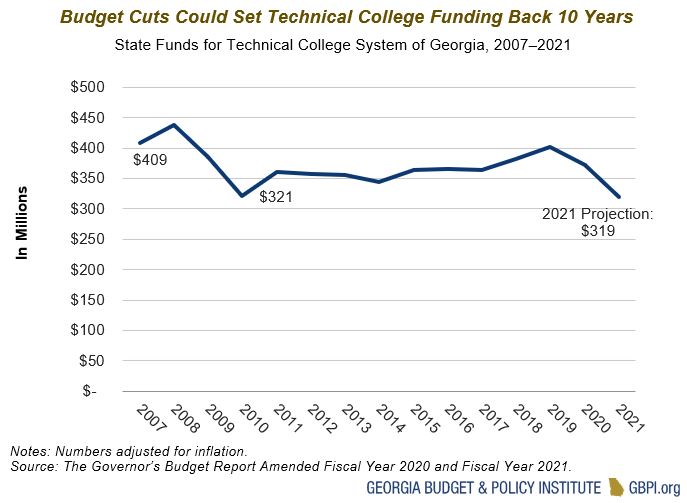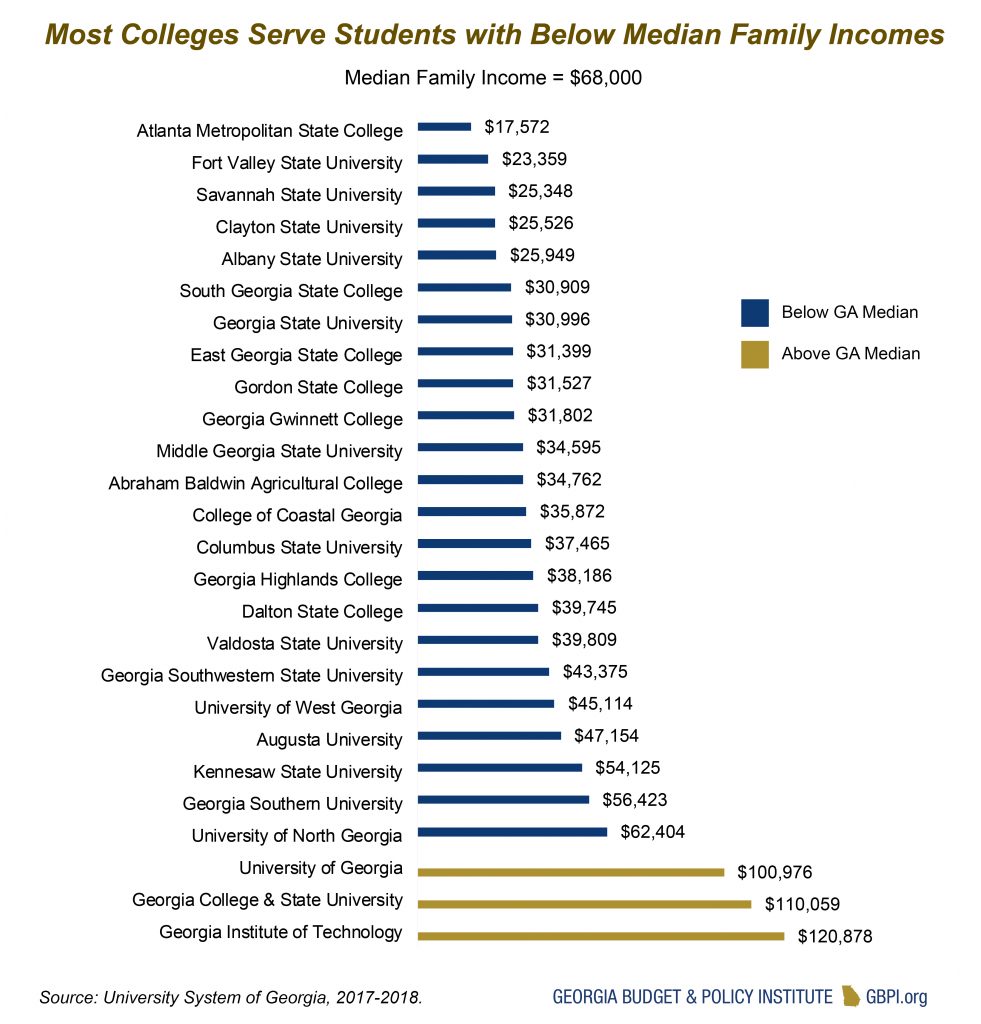Key Takeaways
- Pending budget cuts to the University System of Georgia have the potential to reverse years of progress, lowering instructional quality, increasing dropout rates and hampering upward mobility.
- Similar cuts to the Technical College System could have negative long-term effects as less money flows to colleges for retraining displaced workers and educating Dual Enrollment high school students.
- By modernizing the tax code, maintaining HOPE and prioritizing funding for technical colleges and institutions and programs that support struggling students, lawmakers can mitigate some of the worst effects of the budget cuts.
Big Budget Cuts Would Hurt Colleges, A Key Driver of Economic Mobility
The Governor’s Office of Planning and Budget sent all state agencies instructions to prepare budgets with 14 percent cuts for fiscal year 2021. The Legislature must approve a 2021 budget before the fiscal year begins on July 1. If put into effect, these cuts would be unprecedented in their damage to colleges that are often a lifeline to displaced workers, critical to rural areas and key to economic recovery.
If technical colleges made a 14 percent cut today ($47 million), funding would be set back ten years to the recession’s lowest funding levels, after adjusting for inflation. If technical college enrollment increases, as it did by 25 percent during the last economic downturn, per-student funding would drop by even more. Without additional revenue, resources for technical education will be near its lowest levels in recent history. The federal CARES Act provides an additional $34 million for technical colleges,[1] but this is less even in nominal dollars than the $47 million colleges received in Amended Fiscal Year 2010 through the American Recovery and Reinvestment Act (ARRA).[2]
A 14 percent cut to the University System of Georgia ($361 million) would set funding for colleges and universities close to 2016–2017 funding levels. During the last recession, lawmakers cut funding to the university system for four consecutive years, cutting a total of nearly $417 million. The federal CARES Act allocates $125 million to USG schools for one year to address costs related to instructional changes due to the coronavirus,[3] less than the $257 million schools received in AFY 2010 through the ARRA and with more restrictions on use. The university system estimates revenue loss from refunds and cancellations of professional education and other revenue-generating auxiliary events will total $340 to $350 million by the end of the summer semester.[4]
With budget cuts of this magnitude, lawmakers and families should expect lower quality programs, including fewer course offerings, more limited access to advising and tutoring, larger classes and more part-time instructors. Fourteen percent budget cuts will hurt core instructional and student support services. Public investment in higher education affects dropout rates and even students’ grades, whether students enroll full or part-time.[5] Even with technological tools, people still drive the teaching, research and service that happens at colleges and universities. But to meet budget reduction targets, the university system will have to furlough faculty and staff.
These cuts are detrimental to Georgians seeking to learn skills and improve economic outcomes. Technical colleges act as an education and training safety net for workers during economic downturns. In the last recession, technical college enrollment skyrocketed by 25 percent between the 2009 and 2010 academic years.[6] Georgians who had lost jobs chose to retrain or upgrade skills so they would be prepared for new careers as the economy rebounded.
In fact, technical colleges might be more important than ever. Many jobs that technical colleges train students for, including those in manufacturing, health care, information technology, law enforcement and transportation and logistics, are considered essential industries.[7] Technical colleges are key to rural Georgia’s economic and educational infrastructure. In addition to more enrollment by older adults, technical colleges could see temporary enrollment growth from students choosing lower-priced college, and interest in Dual Enrollment at technical colleges remains high.
The university system is also an important driver of economic mobility. Georgia students who enroll in the university system increase their household income by 20 percent by age 30. The increase doubles for students from high schools serving a high share of low-income families. The state also enjoys long-term gains in tax revenue.[8]
Budget Cuts Across Colleges Would Not Be Felt Equally by Students
The pandemic’s economic effects are not hitting all Georgia families equally. Across the U.S., almost 40 percent of people working in February with a household income below $40,000 lost their jobs in March, according to the Federal Reserve.[9] Black workers account for the majority of recent unemployment insurance claims in Georgia, despite making up 30 percent of the labor force.[10]
Within the university system, colleges and universities tend to serve students from different economic profiles. Seventeen of the 26 colleges and universities serve students with median family incomes of less than $40,000. Though each college serves diverse student populations, overall trends split Georgia public colleges in two tiers regarding family income.
Recommendations
Georgia must continue to invest in higher education to help the state recover and prosper. Federal funding is essential to offset state shortfalls, but state leaders also play an important role.
- To mitigate cuts, lawmakers must modernize and improve the tax code. Commonsense options include raising the tobacco tax to the national average, closing special interest loopholes that cost the state billions every year and removing the itemized tax break for state taxes paid, which is available to only 14 percent of Georgia filers who earn an average of $240,000 per year.[11]
- Prioritize technical college funding. During previous economic downturns, demand for technical education and training surged from displaced workers. Many of these occupations have proven to be essential during the pandemic and are critical to the recovery. Technical colleges are also the biggest provider of Dual Enrollment for high school students, and interest in Dual Enrollment remains high.
- Shield colleges with the lowest-income students from budget cuts. The pandemic’s economic effects are concentrated on lower-income families in Georgia. In general, colleges that serve more students from lower-income families receive less state funding. Research finds increased public funding for non-selective colleges improves persistence and graduation rates.
- Prioritize academic support services. Colleges making decisions about budget cuts should protect academic support services like advising and tutoring as much as possible. These services are sensitive to budgets and make a big difference to student success.
Lottery Funds In Stronger Position Than Last Recession
In addition to state general funds, colleges and universities indirectly receive lottery funds via HOPE Scholarships and Grants awarded to college students. The state budget accounts for lottery funds separately, and lottery funds have two separate reserve accounts. A 14 percent cut to HOPE programs would mean a loss of $122 million. Historically, lottery ticket sales have remained stable during economic downturns. Currently, the lottery projects a slight decrease in FY 2020 due to a sales dip in March, but reports that sales grew in April.[12]
Two important policy changes make lottery funds stronger now than in the previous recession. First, the lottery shortfall reserve requirement grew from 10 to 50 percent of prior year’s net lottery proceeds. In 2010, the shortfall reserves were $87 million; today, they are $572 million.
Second, the 2011 HOPE changes now decouple most scholarships from rising automatically with tuition rates, though Zell Miller Scholarships continue to be tied to tuition. Today, the Georgia Student Finance Commission determines HOPE Scholarship amounts each year based on state appropriations and projections. In contrast, during the last recession, all HOPE Scholarships grew in tandem with tuition and fees increases and covered 100 percent of tuition and fees. Consequently, pressure on lottery funds grew as colleges increased tuition and fees in response to state funding cuts. This year, HOPE spending will not grow from tuition increases at the university system, as the system already announced it would not raise tuition for 2020-2021.
Recommendations
- Lawmakers should maintain HOPE, as lottery revenues are expected to be more stable than state general revenue. Georgia’s large shortfall reserve can fill in the gap if ticket sales fall more than expected.
Endnotes
[1] GBPI analysis of the U.S. Department of Education, Allocations for Section 18004(a)(1) of the CARES Act, https://www2.ed.gov/about/offices/list/ope/allocationsforsection18004a1ofcaresact.pdf
[2] Georgia FY 2010 Budget. http://www.house.ga.gov/budget/Documents/2010_FiscalYear/AFY_2010_Bill_Final_Conf_Cmte_.pdf
[3] Lee, J. (2020, April 17). Federal relief not enough to meet college students’ financial needs. Georgia Budget and Policy Institute. https://gbpi.org/2020/federal-relief-not-enough-to-meet-college-students-financial-needs/
[4] Downey, M. (2020, April 14). Georgia university system losses from coronavirus expected to reach $350M. Atlanta Journal Constitution. https://www.ajc.com/news/local-education/georgia-regents-college-tuition-freeze-amid-expected-loss-350m/BqIq54rbdG269nCzTJz4NP/
[5] Deming D., & Walters C. (2017). The Impacts of price caps and spending cuts on U.S. postsecondary attainment. Working Paper. https://scholar.harvard.edu/files/ddeming/files/DW_Aug2017.pdf
[6] Enrollment measured in Full-Time Equivalents. Technical College System of Georgia End-of-Year Enrollment Report, FY 2010.
[7] Department of Homeland Security, Cybersecurity and Infrastructure Security Agency, Identifying Critical Infrastructure During COVID-19. https://www.cisa.gov/identifying-critical-infrastructure-during-covid-19
[8] Smith, J., Goodman, J, & Hurwitz, M. (2020, May). The economic impact of access to public four-year colleges. National Bureau of Economic Research (NBER Working Paper No. 27177). https://www.nber.org/papers/w27177
[9] The Federal Reserve System Board of Governors. (2020, May). Report on the economic well-being of U.S. households in 2019, featuring supplemental data from April 2020. https://www.federalreserve.gov/publications/files/2019-report-economic-well-being-us-households-202005.pdf
[10] Camardelle, A. (2020, April 17). State of working Georgia before and during COVID-19. Georgia Budget and Policy Institute. https://gbpi.org/2020/state-of-working-georgia-before-and-during-covid-19/
[11] Kanso, D. (2019, Aug 12). The Tax Cuts and Jobs Act in Georgia: High income households receive greatest benefits. https://gbpi.org/2019/tax-cuts-and-jobs-act-georgia/
[12] Georgia Lottery presentation to House Higher Education Committee, May 12, 2020, https://www.youtube.com/watch?v=_r2j6TYk4S0&feature=youtu.be














